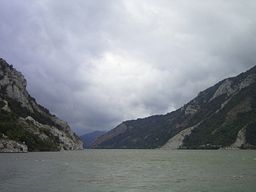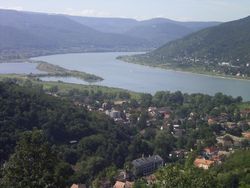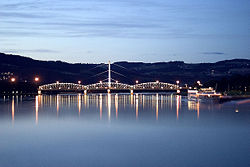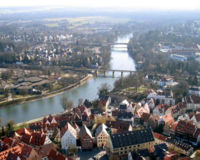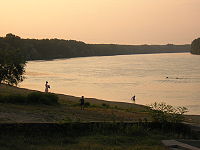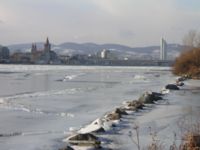Danube
2008/9 Schools Wikipedia Selection. Related subjects: European Geography
| Danube | |
| Donau, Dunaj, Duna, Дунав/Dunav, Dunărea, Дунáй (Dunay) | |
|
The Iron Gate, on the Romanian–Serbian border ( Iron Gate natural park and Đerdap national park)
|
|
| Countries | |
|---|---|
| Cities | Ulm, Regensburg, Passau, Vienna, Bratislava, Budapest, Novi Sad, Belgrade, Drobeta-Turnu Severin, Giurgiu, Măcin, Brăila, Galaţi, Isaccea, Tulcea, Sulina |
| Primary source | Breg |
| - location | Martinskapelle, Black Forest, Germany |
| - elevation | 925 m (3,035 ft) |
| - length | 43 km (27 mi) |
| - coordinates | |
| Secondary source | Brigach |
| - location | St. Georgen, Black Forest, Germany |
| - elevation | 1,078 m (3,537 ft) |
| - length | 49 km (30 mi) |
| Source confluence | |
| - location | Donaueschingen |
| Mouth | Danube Delta |
| Length | 2,860 km (1,777 mi) |
| Basin | 817,000 km² (315,445 sq mi) |
| Discharge | for before delta |
| - average | 6,500 m³/ s (229,545 cu ft/ s) |
The Danube (In German: Donau from earlier Danuvius, Celtic *dānu, meaning "to flow, run", Slovak Dunaj, Hungarian Duna, Romanian Dunărea, Old Norse Duná, Turkish Tuna, ancient Greek Istros, Croatian Dunav, Serbian Дунав/Dunav, Bulgarian Дунав, Ukrainian Дунай) is the longest river in the European Union and Europe's second longest river after the Volga. It originates in the Black Forest in Germany as the much smaller Brigach and Breg rivers which join at the eponymously named German town Donaueschingen, after which it is known as the Danube and flows eastwards for a distance of some 2850 km (1771 miles), passing through several Central and Eastern European capitals, before emptying into the Black Sea via the Danube Delta in Romania and Ukraine.
Known to history as one of the long-standing frontiers of the Roman Empire, the river flows through — or forms a part of the borders of — ten countries: Germany (7.5%), Austria (10.3%), Slovakia (5.8%), Hungary (11.7%), Croatia (4.5%), Serbia (10.3%), Romania (28.9%), Bulgaria (5.2%), Moldova (1.7%), and Ukraine (3.8%)
In addition, the drainage basin includes parts of nine more countries: Italy (0.15%), Poland (0.09%), Switzerland (0.32%), Czech Republic (2.6%), Slovenia (2.2%), Bosnia and Herzegovina (4.8%), Montenegro, Republic of Macedonia, and Albania (0.03%).
Name
The English language has, since the Norman invasion, used the French word Danube. In other languages, particularly those spoken in the countries the river flows through:
- Czech and Slovak: Dunaj
- German: Donau
- Hungarian: Duna
- Slovenian: Donava
- Croatian: Dunav
- Serbian and Bulgarian (Cyrillic only on the latter): Dunav/Дунав (Dunaiiro)
- Romanian: Dunăre, Dunărea
- Russian and Ukrainian: Дунáй (Dunay)
- Latin: Danubius, Danuvius, Ister
- Ancient Greek: Istros
- Turkish: Tuna
- Local Yiddish: Duner - דונער or Tin'e - טינע
One theory ultimately derives all these variations from the Celtic word *dānu, meaning "to flow", and its exact equivalent is found in the Welsh name of the river Donwy. Other theories derive the name from an Iranic root that has contributed the names of all other major rivers emptying into the Black Sea, such as the Don, Donets, Dnieper and Dniestr. See the discussion section on this.
Ancient Greek Istros was a borrowing from Thracian meaning "strong, swift", akin to Sanskrit is.iras "swift", Greek ierós "strong, sacred".
Geography
Tributaries
The Danube River reaches into ten other countries. Some Danubian tributaries are important rivers in their own right, navigable by barges and river boats of shallow draught. Ordered from source to mouth, the main tributaries are:
- Iller - Lech - Regen (entering at Regensburg) - Isar (entering just beyond Deggendorf) - Inn (entering at Passau) - Enns - Morava (entering near Devín Castle) - Leitha - Váh (entering at Komárno) - Hron - Ipel - Sió - Dráva - Vuka - Tisza - Sava (entering at Belgrade) - Timiş - Velika Morava - Caraş - Jiu - Iskar - Olt - Vedea - Argeş - Ialomiţa - Siret - Prut
Cities
The Danube flows through the following countries and cities (from source to mouth ordered):
- Germany
- Tuttlingen in the State of Baden-Württemberg - the first city it flows through
- Sigmaringen in Baden-Württemberg
- Ulm in Baden-Württemberg
- Ingolstadt in Bavaria
- Regensburg in Bavaria
- Passau in Bavaria
- Austria
- Linz, capital of Upper Austria
- Vienna - capital of Austria, where the Danube floodplain is called the Lobau, though the Innere Stadt is situated away from the main flow of the Danube (it is bounded by the Donaukanal - 'Danube canal').
- Slovakia
- Bratislava - capital of Slovakia
- Komárno
- Štúrovo
- Hungary
- Győr
- Komárom
- Esztergom
- Visegrád
- Vác
- Szentendre
- Budapest - capital of Hungary
- Százhalombatta
- Ráckeve
- Dunaújváros
- Paks
- Baja
- Mohács
- Croatia
- Vukovar
- Ilok
- Serbia
- Apatin - province of Vojvodina
- Bačka Palanka - province of Vojvodina
- Novi Sad - capital of the province of Vojvodina
- Belgrade - the capital of Serbia
- Smederevo
- Donji Milanovac
- Romania
- Moldova Nouă
- Orşova
- Drobeta-Turnu Severin
- Calafat
- Corabia
- Turnu Măgurele
- Zimnicea
- Giurgiu
- Olteniţa
- Călăraşi
- Feteşti
- Cernavodă
- Hârşova
- Brăila
- Galaţi
- Isaccea
- Tulcea
- Sulina - the last city it flows through
- Bulgaria
- Vidin
- Lom
- Kozlodui
- Nikopol
- Belene
- Svishtov
- Rousse
- Tutrakan
- Silistra
- Ukraine
- Reni
- Izmail
- Kiliya
- Vylkovo
The Danube flows through four capital cities (shown in bold), more than any other river in the world.
Sectioning
- Upper Section: From spring to Devín Gate. Danube remains a characteristic mountain river until Passau, with average bottom gradient 0.0012%, from Passau to Devín Gate the gradient lessens to 0.0006%.
- Middle Section: From Devín Gate to Iron Gate. The riverbed widens and the average bottom gradient becomes only 0.00006%.
- Lower Section: From Iron Gate to Sulina, with average gradient as little as 0.00003%.
Modern navigation
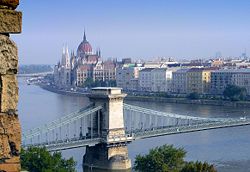
The Danube is navigable by ocean ships from the Black Sea to Brăila in Romania and by river ships to Kelheim, Bavaria; smaller craft can navigate further upstream to Ulm, in Germany. About 60 of its tributaries are also navigable.
Since the completion of the German Rhine–Main–Danube Canal in 1992, the river has been part of a trans-European waterway from Rotterdam on the North Sea to Sulina on the Black Sea (3500 km). In 1994 the Danube was declared one of ten Pan-European transport corridors, routes in Central and Eastern Europe that required major investment over the following ten to fifteen years. The amount of goods transported on the Danube increased to about 100 million tons in 1987. In 1999, transport on the river was made difficult by the NATO bombing of three bridges in Serbia. The clearance of the debris was finished in 2002. The temporary pontoon bridge that hampered navigation was finally removed in 2005.
At the Iron Gate, the Danube flows through a gorge that forms part of the boundary between Serbia and Romania; it contains the hydroelectric Iron Gate I dam, followed at about 60 km downstream (outside the gorge) by the Iron Gate ll dam. On 2006- 04-13, a record peak discharge at Iron Gate Dam reached 15,400 m³/s.
There are three artificial waterways built on the Danube: the Danube–Tisa–Danube Canal (DTD) in the Banat and Bačka regions ( Vojvodina, northern province of Serbia); the 64 km Danube–Black Sea Canal, between Cernavodă and Constanţa (Romania) finished in 1984, shortens the distance to the Black Sea by 400 km; the Rhine–Main–Danube Canal (about 171 km), finished in 1992, linking the North Sea to the Black Sea.
The Danube delta
The Danube Delta has been a UNESCO World Heritage Site since 1991. Its wetlands (on the Ramsar list of wetlands of international importance) support vast flocks of migratory birds, including the endangered Pygmy Cormorant (Phalacrocorax pygmaeus). Rival canalization and drainage scheme threaten the delta: see Bastroe Channel.
Geology

Although the headwaters of the Danube are relatively small today, geologically, the Danube is much older than the Rhine, with which its catchment area competes in today's southern Germany. This has a few interesting geological complications. Since the Rhine is the only river rising in the Alps mountains which flows north towards the North Sea, an invisible line divides large parts of southern Germany, which is sometimes referred to as the European Watershed.
However, before the last ice age in the Pleistocene, the Rhine started at the southwestern tip of the Black Forest, while the waters from the Alps that today feed the Rhine were carried east by the so-called Urdonau (original Danube). Parts of this ancient river's bed, which was much larger than today's Danube, can still be seen in (now waterless) canyons in today's landscape of the Swabian Alb. After the Upper Rhine Valley had been eroded, most waters from the Alps changed their direction and began feeding the Rhine. Today's upper Danube is but a meek reflection of the ancient one.
Since the Swabian Alb is largely shaped of porous limestone, and since the Rhine's level is much lower than the Danube's, today subsurface rivers carry much water from the Danube to the Rhine. On many days in the summer, when the Danube carries little water, it completely oozes away noisily into these underground channels at two locations in the Swabian Alp, which are referred to as the Donauversickerung ( Danube Sink). Most of this water resurfaces only 12 km south at the Aachtopf, Germany's wellspring with the highest flow, an average of 8500 litres per second, north of Lake Constance — thus feeding the Rhine. The European Water Divide thus in fact only applies for those waters that pass beyond this point, and only during the days of the year when the Danube carries enough water to survive the sink holes in the Donauversickerung.
Since this enormous amount of underground water erodes much of its surrounding limestone, it is estimated that the Danube upper course will one day disappear entirely in favour of the Rhine, an event called stream capturing.
Human history
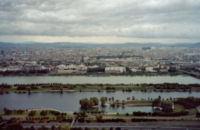
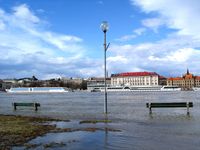
The Danube basin was the site of some of the earliest human cultures. The Danubian Neolithic cultures include the Linear Pottery cultures of the mid-Danube basin. The third millennium BC Vučedol culture (from the Vučedol site near Vukovar, Croatia) is famous for its ceramics. Many sites of the sixth-to-third millennium BC Vinča culture are sited along the Danube. The river was part of the Roman empire's Limes Germanicus.
Of importance for the Danube is also the International Commission for the Protection of the Danube River (ICPDR). The ICPDR is an international organisation consisting of 13 member states (Germany, Austria, Czech Republic, Slovakia, Slovenia, Hungary, Croatia, Bosnia and Herzegovina, Serbia, Bulgaria, Romania, Moldova, Ukraine) and the European Union. ICPDR, established in 1998, deals not only with the Danube itself, but with the whole Danube River Basin, which also includes its tributaries and the groundwater resources. The goal of the ICPDR is to implement the Danube River Protection Convention, promoting and coordinating sustainable and equitable water management, including conservation, improvement and rational use of waters for the benefit of the Danube River Basin countries and their people. The Romans often used the river Danube as a border for their vast empire.
Danube Bike Trail
The Danube Bike Trail (also called Danube Cycle Path or the Donauradweg) is a bicycle trail along the river.
The Danube Bike Trail (Donauradweg) is divided into four sections:
- Donaueschingen- Passau (550 km)
- Passau-Vienna (320 km)
- Vienna-Budapest (330 km)
- Budapest-Black Sea (1670 km)
Cultural significance
The Danube is mentioned in the title of a famous waltz by Austrian composer Johann Strauss, An der schönen, blauen Donau (By the Beautiful Blue Danube). This piece was composed as Strauss was traveling down the Danube River. This piece is well known across the world and is also used widely as a lullaby.
Another famous waltz about the Danube is The Waves of the Danube ( Romanian: Valurile Dunării) by the Romanian composer Ion Ivanovici (1845–1902), and the work took the audience by storm when performed at the 1889 Paris Exposition.
Joe Zawinul wrote a symphony about the Danube called Stories of the Danube. It was performed for the first time at the 1993 Bruckner festival, at Linz.
The Danube figures prominently in the Bulgarian National Anthem, as a symbolic representation of the country's natural beauty.
The German tradition of landscape painting, the Danube school, was developed in the Danube valley in the 16th century.
The most famous book describing the Danube might be Claudio Magris's masterpiece Danube ( ISBN 1-86046-823-3).
The historical fiction Earth's Children series by Jean Auel refers to the Danube as the Great Mother River.
The river is the subject of the film The Ister (official site here).
Parts of the German road movie Im Juli take place along the Danube.
Noted horror writer Algernon Blackwood's most famous short story, "The Willows" concerned a trip down the Danube.
In the PC Space Simulator Freelancer the battle cruiser Donau is destroyed during the first cutscene.
In the Star Trek universe, a class of spacecraft was named after the Danube.
Economics of the Danube
Drinking water
Along its path, the Danube is a source of drinking water for about ten million people. In Baden-Württemberg, Germany, almost thirty percent (as of 2004) of the water for the area between Stuttgart, Bad Mergentheim, Aalen and Alb-Donau (district) comes from purified water of the Danube. Other cities like Ulm and Passau also use some water from the Danube.
In Austria and Hungary, most water comes from ground and spring sources, and only in rare cases is water from the Danube used. Most states also find it too difficult to clean the water because of extensive pollution; only parts of Romania where the water is cleaner still use a lot of drinking water from the Danube.
Navigation and transport
As "Corridor VII" of the European Union, the Danube is an important transport route. Since the opening of the Rhine–Main–Danube Canal, the river connects the Black Sea with the industrial centers of Western Europe and with the Port of Rotterdam. The waterway is designed for large scale inland vessels (110×11.45 m) but it can carry much larger vessels on most of its course. The Danube has been partly canalized in Germany (5 locks) and Austria (10 locks). Further proposals to build a number of new locks in order to improve navigation have not progressed, due in part to environmental concerns.
Downstream from the Freudenau river plant's locks in Vienna, canalization of the Danube was limited to the Gabčíkovo dam and locks near Bratislava and the two double Iron Gate locks in the border stretch of the Danube between Serbia and Romania. These locks have larger dimensions (similar to the locks in the Russian Volga river, some 300 by over 30 m). Downstream of the Iron Gate, the river is free flowing all the way to the Black Sea, a distance of more than 860 kilometers.
The Danube connects with the Rhine–Main–Danube Canal at Kelheim, and with the Wiener Donaukanal in Vienna. Apart from a couple of secondary navigable branches, the only major navigable rivers linked to the Danube are the Drava, Sava and Tisza. In Serbia, a canal network also connects to the river; the network, known as the Dunav-Tisa-Dunav canals, links sections downstream.
Fishing and tourism
The importance of fishing on the Danube, which used to be critical in the Middle Ages, has declined dramatically. Some fishermen are still active at certain points on the river, and the Danube Delta still has an important industry.
Important tourist and natural spots along the Danube include the Wachau valley, the Nationalpark Donau-Auen in Austria, the Naturpark Obere Donau in Germany, Kopački rit in Croatia, Iron Gate and Danube Delta in Romania, the Srebarna Nature Reserve in Bulgaria.
Important National Parks
- Naturpark Obere Donau (Germany)
- Nature protection area Donauleiten (Germany)
- Nationalpark Donau Auen (Austria)
- Duna-Ipoly Nemzeti Park (Hungary)
- Gemenc (Hungary)
- Naturalpark Kopački Rit (Croatia)
- Đerdap National park (Serbia)
- Iron Gate Natural Park (Romania)
- Natural Park Măcinului Mountins (Romania)
- Natural Park Little Pond of Brăila (Romania)
- Biosphere Reserve Danube Delta (Romania)
- Srebarna Nature Reserve (Bulgaria)
- Persina Natural Park (Bulgaria)
